The Bangkok International Performing Arts Meeting (BIPAM) was established in Thailand in 2017 as a development prompted by Thai participation in TPAM –Performing Arts Meeting in Yokohama in 2015. Sasapin Siriwanij, the artistic director for BIPAM since 2018, is initiating international co-production as a producer as well as a member of physical theater company “B-Floor Theatrer”. In this interview we spoke with Siriwanij about BIPAM and how it is attracting attention as a new performing arts platform for Southeast Asians.
Interviewer: Makiko Yamaguchi
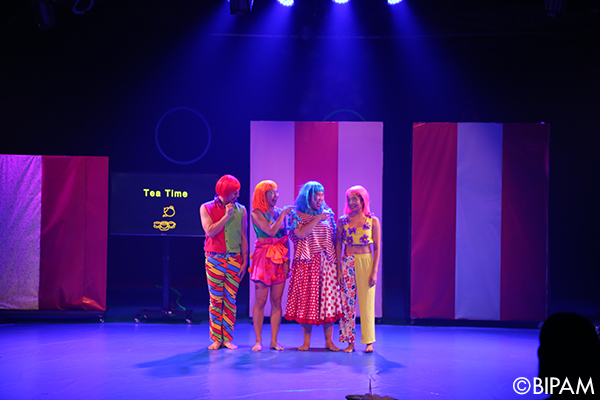
History of BIPAM
BIPAM was established in 2017. It was launched by Chavatvit Muangkeo, commonly known by the name “Should,” who also attended TPAM. I was part of the process of considering the launch, but not the initial BIPAM. At the time, we participated in TPAM and were impressed by its role as an international platform for contemporary performing arts. And the more we learned about the merits of TPAM’s programs, the more we thought that there should be a similar platform in Thailand. So, we used TPAM as a model.
Meeting so many Southeast Asian arts professionals at TPAM was also a very valuable and wonderful experience. However, we felt it was strange that we had to go all the way to Japan in order to meet them for the first time. So, we began to think that we should create a forum where we could meet them in our home city of Bangkok. Bangkok is easily accessible to people throughout the Southeast Asian region, and it can be reached in just an hour by air. Should (Chavatvit Muangkeo) often receives work from the government, so he had experience in government fundraising, and he also had an idea to persuade the government to make such a platform a reality in Bangkok.
I was in agreement with him, but I also wanted to promote discussion in the performing arts community in Thailand. Eventually, I also thought that it would be good to expand the discussion within the Southeast Asian region. In Thailand, there are many vibrant and talented artists developing interesting works and activities, but there was the fear that the scene could reach a saturation point very soon if we didn’t open up ourselves up to other things, other inspirations in the outside world, to meet artists from other countries, to exchange ideas, and to deepen our dialogue. That is one of the keyways to be able to think more deeply about our own practice.
BIPAM combines these visions to make them a reality. The first BIPAM was held as part of the program of the Bangkok Theatre Festival. It was, so to speak, the international section of the festival. This made BIPAM known to the public, but we had so many plans in mind for the next year’s event that we decided to hold it separate from the festival.
There were considerable differences in content and financial resources, and there were also slight differences in vision, but we wanted to support each other, so we initially tried to hold the event at the same time. We tried to make it possible for people to visit the festival as well, but it didn’t actually work as well as we had anticipated, so now we don’t try to time BIPAM to coincide with the festival’s schedule, although we still support each other in other ways.
Should did all the planning and management of the first edition of BIPAM himself, but he was also thinking it would be better to do that way only once. For the first edition, many people gathered and had meaningful dialogues, but it was also clear that a certain amount of direction would be needed to continue it after that.
So, I took on the task of curating the planning and content of the BIPAM program, and we formed a committee to do the planning together. In addition to myself, the committee members are Jarunun Phantachat (co-artistic director, director, actor and producer of B-Floor Theatre) (*1), Wichaya Artamat (playwright, director) (*2), Amitha Amranand (theater critic) (*3), and Parnrut Kritchanchai (actor and director), who has deep ties to the Thai community. This committee has curated BIPAM programs every year since.
Since the start of BIPAM, we have always had to face various uncertainties. We’ve been defensive, in a good and bad sense, and we’ve responded to things we didn’t expect, and we’ve made changes and adjustments.
The legal status of BIPAM is not a non-profit organization, but a company limited. Thailand does not have a non-profit organization system, and the only applicable legal status was a company limited. However, this also has merits, and it is not subject to the government’s arts and culture support system, so we can freely do what we want to do. If something doesn’t work, we can change it immediately for the next time. We don’t have the commitment to continue what we started out with anyone, and the only ones you have to explain things to is the community.
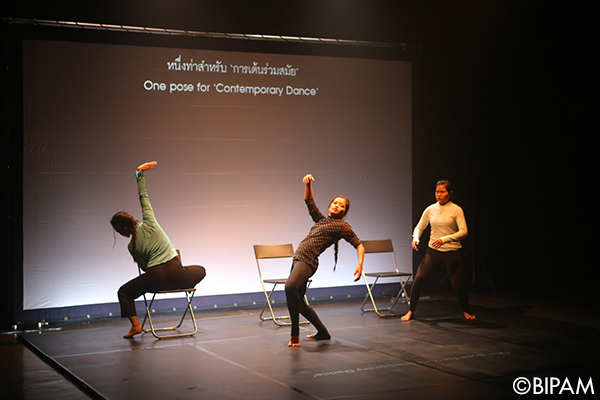
About the BIPAM Program
-
I participated in BIPAM in 2018 and I thought it was organized very well. The contents of the discussions were also intense, and there was also a substantial showcase program. I also saw a combination of works including Bangkok contemporary dance and traditional Myanmar dancers and puppeteers, and I got the feeling that bold new things were being experimented with.
When it comes to planning a program, it is often conversely inspiring to be faced with shortcomings and limitations. We dream of doing big things, but we don’t really have a large budget. We get funding from a variety of partners, but of course what each partner wants are different. I believe that this brought out a great deal of creativity in our planning process, and led to the commissioning of many works, which in turn becomes a signature aspect of BIPAM.
It’s a contradiction, isn’t it? We don’t have a lot of money, but I’m actually commissioning new works, but what we commission is really small works. However, I believe that it is precisely by commissioning new works like this that we can communicate our message to the community. It’s very exciting to bring together artists to create a new work. For the first time, the artists will be working together in collaboration and a dialogue will be born in the process.
Back in 2018, it was mostly the process that was important. But at the same time, I think we also realized that it’s important to have a certain result, or at least the result in mind, so that you can keep working to produce concrete results and can thus deepen the practice of the process. Even if you focus just on encounters, you can be more oriented if you keep in mind the goal and the end point to some extent.
In 2018, the artists literally met and created works in a very short period of time in a showcase format. After that, the scale remained small, but we started to take enough time for the artists to meet, and we also provide enough time for them to have thorough discussions and do research.
We have continued to do this, and now I think we are getting better at deepening the process of research and collaboration. Sometimes it is true that the work doesn’t always come out as a production, but as a project for incubation. For example, The City & The City (*4), which is the project we do with Festival/Tokyo director Kaku Nagashima-san. In a recent project we did with The Asia Culture Center in Gwangju, South Korea, artists spent three months conducting research online and presented their results in the form of an exhibition. Ideally, we would like to provide enough time for research and focus on the process, and then hopefully the result will be a production in the end. And we may be able to achieve this in the near future.
That’s right. There are showcases and talk programs, the latter of which will include presentations, panel discussions, artist talks, and, to a lesser extent, there are some workshops by the artists invited to the showcases. In addition, networking is also important as one of our programs.
We knew that for the people who attend BIPAM, it was very important to provide opportunities to interact outside of formal venues such as panel discussions. So we provide a carefree place with fried chicken, French fries and beer for them to network at ease. In many cases, something comes out of those opportunities, so we’ve incorporated those networking opportunities into our program as well. We really think that it’s an important part of BIPAM, and I think we’re quite good at making that happen.
I have been setting a theme every year since 2018, when I first became involved. In 2018, the theme we chose was Root Routes, implying a combination of traditional arts and contemporary arts. Then I went on to set themes of Eyes Open (2019), Under the Sea (2020) and Ownership (2021). Setting a theme gives you a clear direction and clarifies what you want to talk about on the platform. However, we are currently considering whether or not to continue setting themes in the future. It is a question of whether themes are really beneficial in curating BIPAM or, rather, put unnecessary limits on it. There are other things that we want to realize with BIPAM, so I think it would be better to adopt themes that are more open to interpretation and possibilities.
In 2018 and 2019, I had only recently become an artistic director, so for me, setting a theme was the most pressing matter. For example, with Root Routes, we were desperate to figure out how to make BIPAM meaningful as a platform, how to involve the government, and how to get as many people as possible to interact with us. In Thailand, the government is often most interested in the traditional performing arts. My background is contemporary, so I was thinking about what kind of dialogue is possible between the traditional and the contemporary arts.
The government didn’t seem interested in this approach, so 2019 was about responding to society, which was our concern. That was the idea behind the Eyes Open theme, and most of the content was about violence. We wanted to deal with this ever-present reality throughout the Southeast Asian region, and it became an exchange at a new level. The history of this region, including the modern history in which we live, is full of violence. And interestingly, most of the time in Southeast Asia, people are always trying to ignore this fact or to laugh it off. I think the trauma is so great that people can’t continue talking it. We believe that by creating a space to fully recognize this shared history of violence in the region, will be possible to create a greater sense of solidarity with each other by different means, and so we made this the theme for the 2019 BIPAM.
The theme for 2020 was the response to the COVID-19 pandemic in general. After the end of the 2019 BIPAM, it was decided to switch from holding the event every year to every other year. However, 2020 was so uncertain that we could not find any point in thinking about plans for 2021 and beyond. So we decided to rethink our plans and decided to make 2020 a meeting for us to talk about what we really wanted to talk about at that point in time. We wanted to know what our friends were doing at that time and how they are adapting to the (COVID-19) situation. We presented this idea to all 11 countries in Southeast Asia and held an 11-week series of talks and programs. Every week, we succeeded in getting speakers from all over Southeast Asia, and it turned out to be successful for everyone, including my friends.
-
In 2021, you collaborated with the Indonesia Dramatic Reading Festival (IDRF) (*5) for the first time. Do you think BIPAM has become a creative platform for performing arts practitioners, researchers and critics during its five years?
I would really like to think so, because that’s what we wanted to achieve. However, it is the people in the community who have to judge it, and it is not right to make that claim by ourselves. However, I have heard such opinions from people in the (Southeast Asian) community many times before, and I am very grateful that they have evaluated BIPAM in this way.
We have repeatedly stated that we want to serve as a hub for Southeast Asia. If you are looking for a place to talk about and get to know Southeast Asia, I want to recommend you begin with BIPAM. But I must also point out that there are other platforms besides BIPAM that have the same intention in Southeast Asia, although they have different formats and focuses. They are Indonesian Drama Reading Festival, Pesta Boneka puppet festival (organized by the Yogyakarta’s Papermoon Puppet Theatre) (*6), Indonesian Dance Festival (*7) and the like.
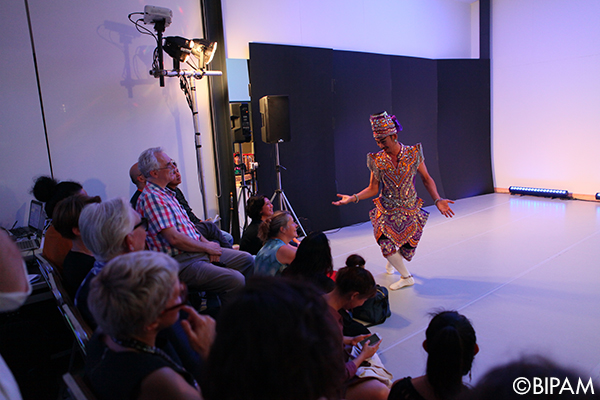
Challenges Facing BIPAM
From the very beginning, we have always had to work in uncertain situations. We’ve been on the defensive, dealing with things we didn’t anticipate, for better or for worse, and we’ve made changes and adjustments.
Funding is still a major issue, but the problem is that there is no arts and culture support system that we can use rather than money itself. It’s not that the country doesn’t have that money, but it’s not allocated in the way the art world needs it, and it’s not in cultural policy. This is the reality, but I hope that it will gradually get better.
In addition to collectives like BIPAM in Thailand, in Bangkok there is also the Thai Theater Foundation, as well as a network of producers and other festivals. People of the same age as myself are active in these groups. We sometimes get together to hold meetings, and we work together in contacting politicians and political parties and trying to be involved in policymaking on behalf of the community. I hope that each of these efforts will lead to some kind of change, and that it will bear fruit in 10 or 20 years, even if only in a small way.
It is a foundation that was established after the establishment of BIPAM. I think it was a year or two later. The director is Raksak Kongseng, who studied theater at a university in Bangkok. Currently she lives in New York, but she works remotely with the Thai team on a constant basis.
Actually, one of the members of the BIPAM team also works for the Thai Theatre Foundation. Many of the members of the collectives are engaged in two or three collectives, and at the end of the day, the theater community here has only 10 to 15 performing arts managers and producers at mos t. I am also a member of the Producers of Thai Performing Arts Network (POTPAN), and I’m a member of the B-Floor Theatre (an artist collective based in Bangkok known for its physical theatre combining multimedia elements). I’m also in For What Theatre, a three-person theatre collective.
There are always challenges, but we are devising various ways to work things out. One of them is that BIPAM is a company limited, and that helps in securing funds because we can get commissioned works and outsource our services to outsider groups. We also undertake work from the Japan Foundation’s Bangkok office, as well as curation for commercial festivals. This kind of work is also interesting for us, but there is also the problem that it expands our activities quickly and management becomes difficult.
As the COVID-19 pandemic began, our activities rapidly became known both domestically and internationally by many institutions. We became aware of the full potential of BIPAM anew, and this made us feel that we could do various new things, so we are taking on the challenge to develop on these opportunities.
We hold a series of talks on the performing arts with experts in science and technology, and continue to interact with our Canadian peers. We are running an online artist exchange project with an independent theater creators’ association in Israel (EVE). When I get new opportunities through BIPAM, I want to pass them on to people in the community elsewhere. Before I knew it, there were a lot of projects going on, but we were only a team of five people, making up of an arts manager and a producer. There are still very few experienced producers and arts managers in Bangkok, and although they are aware of the need for such positions, they have not yet had the time to train newcomers.
The first two times, doing BIPAM in 2018 and 2019, I was indeed burned out. The current team was formed at the time of the pandemic and is so committed. Everyone is committed enough to representing BIPAM that they are now able to truly work as a team. Siree Riewpaiboon, who was an employee of the Bangkok Japan Center, is also a member and has become one of our powerful key players.

What Is a “Community?”
It depends on the contents of the activity. For example, the aforementioned talk series on performing arts with scientists and technicians is a program to find out what the community in Thailand or Bangkok needs, to provide what is missing, and to think about the future as a local Thai community.
On the other hand, until now, we have engaged Southeast Asian communities as much as possible whenever we have the opportunity. This is the case with the Canadian presenters involved in CAPACOA (*8) that we are currently working on, and for this we have formed a group of Southeast Asian stakeholders. We don’t really have people working in the role of presenter like it is used in the Western sense, so we talked to seven people who are talking now with the people in Canada in that role. BIPAM has become an important place to meet and socialize, but apart from that, I am working on many small projects such as these talk series.
For example, there is a series titled “Blur the Lines, Redefine the Borders.” In it, BIPAM invites performing arts artists who are interested in building bridges between performing arts and science and technology and to have them conduct research on science and technology. Working slowly and long enough, we are helping artists and technologists to meet and engage in dialogue on their own, and to be able to launch their own projects.
We are planning to continue this series in the coming years. We don’t have any knowledge of technology, but we know we’re missing some pieces. In order to fill this gap, I would like to take the time to build relationships with partners in other countries and look for ways to deepen meaningful dialogues and exchanges that do not end with temporary panel discussions. BIPAM will develop projects to build bridges for artists and practitioners as much as possible in Thailand and Southeast Asia.
-
Speaking about the performing arts community in Bangkok, I have the impression that people are very supportive of each other. Even if the theater companies to which people belong are different, they support each other, and I think that the organic and lively community is one of the strengths of the Bangkok theater world.
I also think that is one of the strengths of the Bangkok community. However, in a way, it is also narrow. You always have the same faces coming together, and because they all know each other well, they know who to contact immediately if some need arises. For example, if someone is thinking about an international production or a touring internationally, most people will contact me. It’s like a family, so to speak, and I grew up in this community as an artist. So, the Bangkok Theatre Festival is like a big family gathering where everyone gets together every year.
The next meeting is scheduled to be held in March 2023. There will be no real change in the program structure, but I would like to think about new things from the perspective of the post-COVID-19 era. Of course, I want people to come to Bangkok because we want to meet and talk to everyone in person, but now it is not as easy as before for many people to decide to travel long distances. This is just an example, but instead of sitting in a room in Bangkok and listening to the presentations while looking at slides on a projector, I am thinking about moving the venue outside, or going on a trip together as a group and visiting multiple places while talking in the process. I want to think about the impact of COVID-19 and what the reality we are facing right now is. Our realities have been changing at a very rapid pace since the pandemic. Some platforms are fully back on-site, while others continue to be held online. BIPAM is exploring where it should be as an independent collective.
As for the theater world, we’re back to the pre-pandemic norm and its very active. Not only with theatrical performances, but also art exhibitions, festivals and concerts. My impression is that everything is back to normal. The commercial spaces that are mainly owned by real estate companies could not be fully utilized during the pandemic, but now they are offering artists spaces to use. The lack of space has long been a serious problem in Bangkok, so I think this is a very good trend. It is not the same as artist having their own spaces and running them, but I would like to see if this can be a positive new change.
The restrictions imposed during the pandemic have been eased, and while bars had been prohibited from serving customers after 11 p.m., they are now permitted to stay open until 2 a.m. like before the pandemic. On the other hand, measures imposed in relation to the state of emergency are still in place. The current military government is not going to change that. So, it’s a very strange situation. The current trend is for everything to open up, and although it has nothing to do with art, marijuana has also been legalized. On the other hand, strict restrictions imposed on us by the military junta are still enforced.
There may not be many visible confrontations anymore, but the traumatic feeling continues. People are so tired of the attacks and confrontations that they no longer want to leave their homes. Street demonstrations and squabbles have decreased, but that doesn’t mean that the accusations, kidnappings and arrests aren’t still taking place close around us. It’s not that anything is happening right now, but there’s a sense of possibility that if you try to do something more outspoken, you may get into trouble.
Yes, that’s right. It is also very important to have international connections. You can actually rely on them when something serious happens.
As a Producer and as an Artist
-
I would like to ask you about your work as a producer. Recently, you have produced two works by Wichaya Artamat. Both productions toured in Europe and were well received. One of them, This Song Father Used to Sing (Three Days in May), will tour Europe again this summer. When producing works written in these Thai contexts, do you make any special considerations to accommodate foreign audiences?
As for Wichaya’s work, I didn’t produce it from scratch. This Song Father Used to Sing had already been created, and it is a work that he himself has worked on many times since then, so I think it can be said that it is his personal project. After the invitation to the European festival was decided, I joined him working on the realization of the shows.
Also, for the second piece, Four Days in September (The Missing Comrade), Wichaya and I exchanged opinions about the idea behind the work. In particular, we exchanged views with our co-production partners, Kunstenfestivaldesarts (Brussels), Wiener Festwochen, Festival d’automne and Black Box Teater (Oslo) on how to develop the work and how to successfully deliver it to the audience. I wouldn’t say that the results were the best possible, but I think we found a better way to get European audiences interested in the work.
But we don’t think about European audiences ourselves. Wichaya always thinks about Thai society and creates his works in his own way. So, I felt that what I had to do was to advise him not to think about how to please anyone, but to do as he has always done in the past. In that way, the work would speak for itself.
If you need the “internationalization” of a work, I will support Wichaya. For example, for the European performance of Four Days in September (2021), we decided to distribute a chronology of Thai political history to the audience. That decision was made after consulting with him.
That’s my role in the process of Wichaya’s work, not actively intervening in the artistic process, but providing support for the artist. I trust him so much that I let him continue to do what he’s doing. Then we talk to each other about what we need to do in order to deliver effectively to the audience.
However, sometimes I do give feedback and comments at the stage when the script is not yet complete. For example, the joke can be laughed at in Thailand, but it may make a European audience feel uncomfortable, so I suggest cutting it out. I’ve also done workshops and exercises for actors, for rehearsals or as warm-ups.
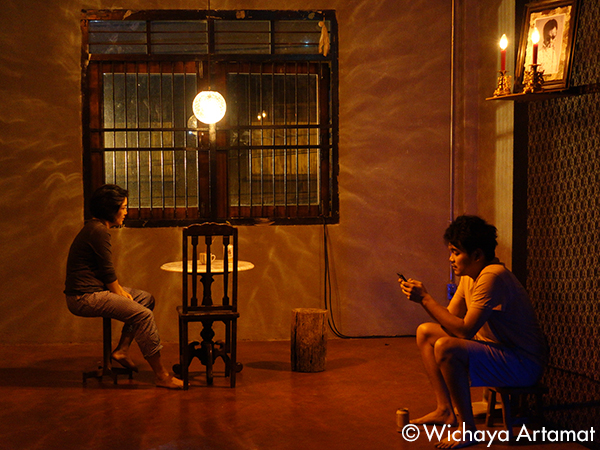
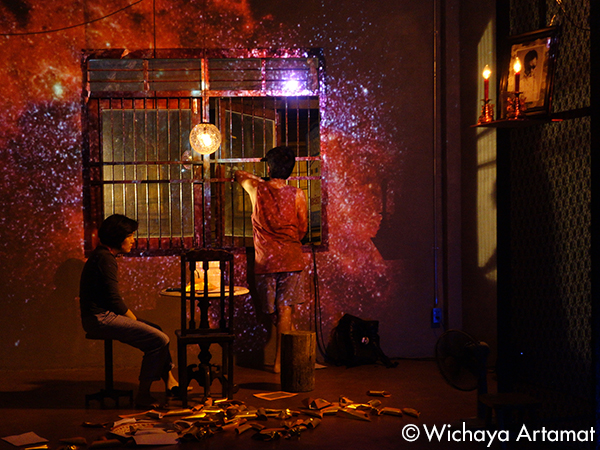
This Song Father Used to Sing (Three Days in May)
One of the representative works of Wichaya Artamat depicting May 17, May 19 and May 22, which have important meaning in Thailand’s modern history. Siblings return to their parents’ home in Bangkok to pay for their father’s death day every year and talk about memories and recent conditions in the kitchen. This production was invited 2019 to Kunstenfestivaldesarts in Brussels as well as Wiener Festwochen. Also performed right before the pandemic at Blackbox Teater in Oslo. It was scheduled to be performed at KYOTO EXPERIMENT in 2021, but due to COVID-19, it was changed to video distribution. It has toured again in Europe in the summer 2022.
https://kyoto-ex.jp/en/shows/2021s-wichaya-artamat/
https://kyoto-ex.jp/magazine/sho-fukutomi2021s/ (Japanese only)
(C)Wichaya Artamat
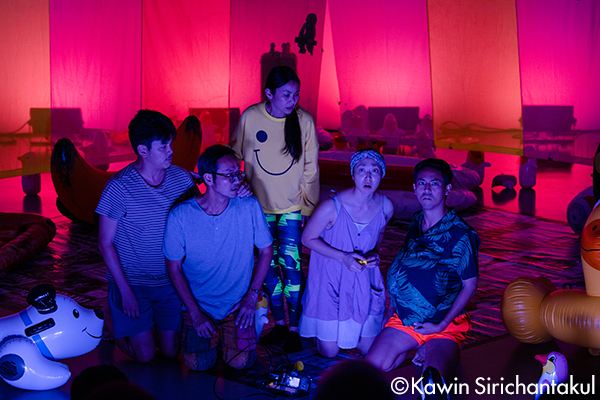

Four Days in September (The Missing Comrade)
Wichaya Artamat’s work alludes to Thailand’s 30-year history with the keyword “disappearance,” such as the destruction of historical evidence and the abduction of activists. This production was co-produced by and invited to Kunstenfestivaldesarts (Bruselles); Wiener Festwochen; Black Box Teater (Oslo); MC93 – Maison de la Culture de Seine-Saint-Denis (Bobigny); Festival d’Automne à Paris.
(C)Kawin Sirichantakul
That is I Don’t Care ไม่ว่าอย่างไร (*9). It was project initiated by the artist. The director, Jarunun Phantachat, is acquainted with the German writer Jürgen Berger and the work is based on Interviews with eight transgenders in Thailand and Germany. I joined in the work on the production a little while later, and also in this case, I was not involved in the creative process very much, but I did offer suggestions and advice on how to develop the work.
I worked in consultation with Jürgen and also with the directors (Anna-Elisabeth Frick and Jarunun Phantachat). This project was a collaborative production, so I provided support when there was a need to reach agreement between the two directors and in deciding which were the next questions the team had to work out. Again, I don’t intervene in the artistic process unless I’m participating as an artist.
Residenztheater is very professional. I have great respect for the way they work with international artists and also with small-scale, experimental creative styles. In particular, I have had good mutual understanding with the people there that I worked with directly, and I feel very fortunate to be able to create new works together with such teams and to be able to participate in the productions.
I usually call myself a theater artist or a movement-based performer. In my own creations, such as “Oh! Ode”, the live sculpting solo piece, I present works of performance art, but recently I have just directed an ensemble that is more like a dance piece. The title of the work is “Vessel” and it’s an all-female production exploring femininity. And I have just done a video installation for an exhibition for the first time.
I definitely have strong roots in the body with physical theater and with movement. I also have a strong theater background, and as you know, I have ventured into the world of dance quite a lot lately too. The other part of my work is about empowerment and being a woman. My work is usually either about the significance of being a woman in society or finding ways to empower. Of course, the target of empowerment is not only myself, but also others, individuals and citizens. The body and empowerment are my two main themes and the path I have walked as an artist. This kind of defines my trajectory as an artist, but it always involves these two aspects.
The original article was published on The Japan Foundation and can be found on https://performingarts.jpf.go.jp/E/pre_interview/2207/1.html
—-------------------------------------------------------------
*1 Jarunun Phantachat
https://asiawa.jpf.go.jp/en/culture/features/f-ah-tpam2019-jarunun-phantachat/
*2 Wichaya Artamat
Playwright, theater director and member of For What Theatre. Born in 1985 in Bangkok, Thailand. After graduating from Thammasat University with a major in film, he became a project coordinator for the Bangkok Theatre Festival in 2008. In 2015, he co-founded For What Theatre with Sasapin Siriwanij of B-Floor Theatre and Ben Busarakamwong of Crescent Moon Theatre. Taking up the relationship between personal history and politics with his unique theatrical approach, he is one of the most noteworthy young directors in the Thai contemporary theater world.
*3 Amitha Amranand
https://asiawa.jpf.go.jp/en/culture/features/ah-tpam2020-three-critics-interview/
*4 The City & The City
Exchange program between BIPAM and the festival/tokyo. It started in 2019, and in 2020, a team of three artists from each of the two cities of Tokyo and Bangkok has participated. They conduct research on the cities in which each person lives, and exchange the process online. As a final presentation, a virtual tour was conducted at venues in two cities.
https://www.festival-tokyo.jp/20/en/program/bipam.html
*5 Indonesia Dramatic Reading Festival (IDRF)
This is a platform for new Indonesian plays that started in Yogyakarta in 2010 in the wake of an Asian Playwrights Meeting held in Tokyo in 2009. Also introducing foreign plays translated into Indonesian.
https://performingarts.jpf.go.jp/E/pre_interview/2109/1.html
*6 Pesta Boneka
https://www.pestaboneka.com/
*7 Indonesian Dance Festival (IDF)
Indonesia’s largest international dance festival has been held every two years in Jakarta since 1992. In addition to dance performances invited from Indonesia and overseas, the program provides opportunities for young artists to learn, develop their ideas, and perform their works.
https://indonesiandancefestival.id/
*8 CAPACOA
Canadian Association for the Performing Arts (l’Association canadienne des organismes artistiques). An organization whose members include presenters, festivals, companies, and agents involved in performing arts performances and tours.
https://capacoa.ca/en/
*9 I Don’t Care ไม่ว่าอย่างไร
An international co-production by B-Floor Theatre in Bangkok and the Residenztheater in Munich. Inspired by interviews with transgender people in Thailand and Germany between 2017 and 2022 by journalist and writer Jürgen Berger, the piece explores the theme of self-determination of identity. Co-directed by B-Floor Theatre choreographer, director and co-director Jarunun Phantachat and German director Anna-Elisabeth Frick. Nontawat Numbenchapol, video artist as well as actors Pathavee Thepkraiwan and Sarut Komalittipong from Thailand and Mareike Beykirch, member of the ensemble of Residenztheater participated. After the world premiere in Bangkok in September 2022, the show will be performed in Munich in October.
https://www.residenztheater.de/en/stuecke/detail/i-dont-care
*10 Pratthana- A Portrait of Possession
This theatre piece is based on a novel by Uthit Haemamoon, a work of contemporary Thai literature, and the piece was written and directed by Toshiki Okada, with a scenography by Yuya Tsukahara (contact Gonzo). It depicts the contemporary history of Thailand and one artist living there. With a cast of 11 Thai actors, it had its world premiere in Bangkok in 2018, after which it was performed at the Centre Georges Pompidou in Paris at Festival d’Automne Paris/Japonisme 2018, and then in Tokyo at Asia in Resonance 2019.
https://www.pratthana.info/en/